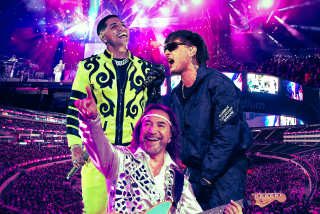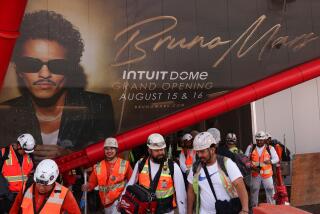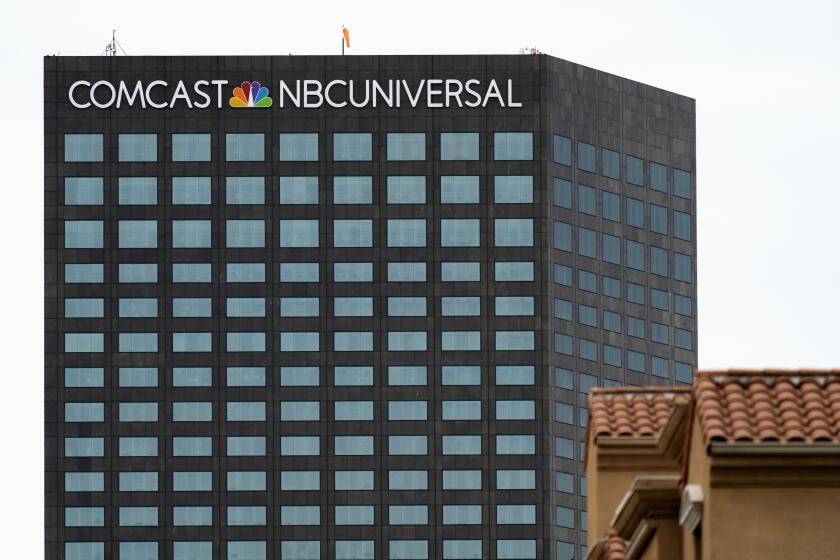Will L.A. Live be life of downtown party?
When L.A. Live, the $2.5-billion entertainment district across from Staples Center, first broke ground in September 2005, downtown Los Angeles was riding high, and the sky seemed the limit.
Block by block, decades of grime were being replaced by trendy eateries, loft dwellers and their dogs. Thirty-two skyscrapers were in the planning phases. And L.A. Live, with clubs, restaurants, convention-center hotels and a 30,000-square-foot Grammy museum, was being called Times Square West.
Three years later, as L.A. Live celebrates its opening beginning today, the mood in downtown is decidedly different. The building boom has slowed, and some landmark projects, including Frank Gehry’s Grand Avenue and the 77-story Park Fifth tower, have been delayed.
In many ways, the economic downturn is putting more pressure on L.A. Live to succeed, with many hoping the entertainment complex will be the draw downtown boosters have often said the city center needs.
“We always felt the pressure that we were important to the event business, to the tourism business,” said Timothy Leiweke, president and chief executive of the Anschutz Entertainment Group, which owns both L.A. Live and Staples Center. “But add to that the stress of the economy -- it puts an even bigger burden on us. There are more expectations on us. We are the lone one standing in terms of getting this entertainment district built, while others have had to be put on the back burner or delayed.”
These days, there is a slightly Dickensian feel amid the flashing screens and curved lines of L.A. Live.
On the one hand, L.A. Live is a VIP’s nirvana, with creature comforts built into most of the complex’s venues. There’s the small theater inside the 30,000-square-foot Grammy Museum where a publicist promises that Justin Timberlake might give an intimate concert for a few close friends after doing an arena show at Staples Center or Nokia Theatre across the way. In the luxe VIP space inside the Conga Room, owners Jimmy Smits and Jennifer Lopez might hold private parties, on display in a fishbowl-like space with a glass wall separating them from the rest of the club. And, it is suggested, Christina Aguilera or Kanye West might bring a few friends after a concert to the exclusive area inside the cavernous Lucky Strikes bowling alley and bar, with two separate lanes and bar marked by white leather couches.
At the same time, L.A. Live has been facing the challenge of marketing a venue that is trying to be upscale in an area that is not completely upscale itself. The Los Angeles Police Department has been working closely with AEG to ensure that there is a heavy security presence around the complex. And AEG helped fund a state-of-the-art LAPD substation in Staples Center, complete with a “smart board” to display crime and deployment information and a LiveScan fingerprint machine.
The LAPD plans to have 12 to 18 officers at L.A. Live, depending on what events are planned. In addition, the department is sometimes posting undercover vice officers in L.A. Live’s clubs, hoping to crack down on public drunkenness, drug sales and other crimes before they spread, as well as a team on the lookout for drunk drivers leaving the clubs and another focused on possible gang activity.
Officials said L.A. Live is something new to them: An upscale, adult-oriented, alcohol-rich venue without the barriers of a Universal CityWalk or Irvine Spectrum and near some tough neighborhoods.
“It’s a challenging job, because it’s unknown to us,” said LAPD Capt. Jodi Wakefield.
--
Police presence
At 8:40 p.m. on a recent Wednesday, LAPD Sgt. Kathy McAnany was finishing a Red Bull with a straw as she monitored activity at L.A. Live. Like the officers she commands as part of a special entertainment unit operating out of L.A. Live, McAnany was wearing a gold pin on her uniform, the arching angel that is the L.A. Live logo.
The officers in the special unit have skills that range from fluency in Chinese and Korean to anti-terrorism. They train in crowd control and in recognizing possible suicide bombers or IEDs.
McAnany sometimes sounds like a booster for the project. “I’m so happy with what’s going on,” she said at one point. “It’s going to generate so much revenue.”
Still, she was focused on keeping things under control. Club Nokia had opened a few weeks earlier, and that night, rapper Nas was on stage. A text message from an officer inside the venue told McAnany that three people had been ejected from the club for intoxication.
A few hundred feet away, the Nokia Theatre was relatively calm -- unless you count the few thousand screaming women who were cheering for New Kids on the Block as they danced and gyrated across the stage. And a Clippers game at Staples Center was about to come down to the wire.
McAnany was not taking chances, though. A large police van, nicknamed “Old Blue,” was parked between the Nokia Theatre and Staples, manned by one of the detail’s officers. And three black-and-white patrol cars were stationed nearby. Two uniformed officers were posted outside Club Nokia’s main entrance, and another two outside the club’s separate entry for VIPs, in addition to the venue’s own security. Guards used hand-held metal detectors to check each person as they entered the venue. “Everyone gets wanded,” McAnany said. “Even the VIPs.”
--
Standing out
The 4-million-square-foot L.A. Live complex marks a distinct shift in the type of development downtown L.A. has witnessed during its nearly decade-long revitalization. The changes began small, with old bank buildings being remade as residential lofts, and eventually grew to include some ground-up construction. New residents, many of them young professionals drawn to the city life who didn’t mind some of its hassles, flocked to the area, which now has a population of nearly 40,000.
But L.A. Live is on an entirely different scale than those previous efforts, and it is focused both on drawing suburbanites and tourists into the city center and serving the nearly 50,000 college students that AEG estimates live or go to school in the area.
It is also distinctly high-end, with a 123-room Ritz-Carlton hotel and 224 upscale condos that share the hotel’s staff and amenities. Those parts of L.A. Live are still under construction and scheduled to open in 2010.
“It’s different from the rest of downtown, but it is very much becoming part of downtown,” said Tom Gilmore, who developed some of the first loft conversions in the Old Bank District.
The biggest question for now is how L.A. Live will fare with the economic downturn.
The complex is packed with the kind of high-end establishments that do well in good times but not always in bad times. They include the Conga Room nightclub, Lucky Strike Lanes & Lounge, and Club Nokia -- and eventually restaurants like the Yard House, the Farm of Beverly Hills, Fleming’s Prime Steakhouse, Lawry’s Carvery and Trader Vic’s. A West Coast broadcast center for ESPN is at one end of the complex, with an ESPN Zone restaurant and bar on the ground floor.
But AEG and downtown boosters are counting on the cachet of the scene -- entertainment award shows, including the Grammys and the Emmys, at the Nokia Theatre; the Lakers, Clippers and Kings next door at Staples Center; and concerts and live broadcasts from the plaza -- to draw people from across Southern California and beyond.
“No one wants to go into the eye of the storm,” Leiweke said. “You certainly don’t want a hurricane. And that’s what we see with the economy. . . . That’s why you are seeing us producing the extravaganzas. We have to capture people’s attention, and draw people down here.”
--
More to Read
The biggest entertainment stories
Get our big stories about Hollywood, film, television, music, arts, culture and more right in your inbox as soon as they publish.
You may occasionally receive promotional content from the Los Angeles Times.










